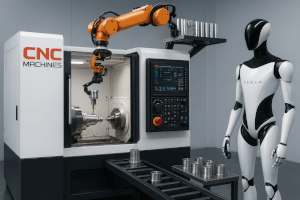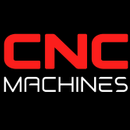The Future of CNC Automation: Flexible Robotics, Rail Systems, and Mobile Machine Tending

The Future of CNC Automation
In the race to higher throughput and lower overhead, the CNC world is on the cusp of a new automation frontier. Gone are the days when a robot guarding a cell beside a machine was cutting-edge. The next generation of CNC automation emphasizes flexibility, space efficiency, and lifelike dexterity robots that slide over railways, hover above machining lines, and roam freely between cells.
This article dives deep into the robotics platforms shaping today’s CNC shops (FANUC, Universal Robots, Kawasaki, etc.), the mounting strategies (front rails, overhead gantries, mobile bases), real-world case studies, and a future vision in which robots may truly act like machinists themselves.
Leading Robotics Platforms in CNC Automation
Before exploring layout strategies, it's helpful to understand the capabilities, strengths, and constraints of major robotics brands in machine tending and automation.
| Brand / Platform | Strengths & Use Cases | Key Challenges / Constraints |
|---|---|---|
| FANUC (e.g. LR Mate, R-series, M-series) | Very mature, high uptime, strong ecosystem of integrators. For example, APT Manufacturing automated a FANUC ROBODRILL with a FANUC robot and achieved 33% more production and a 33-week ROI. ([fanucamerica][1]) | Higher cost, more complex integration overhead, less flexible in small runs |
| Universal Robots (UR series) | Ease of programming, collaborative safety features, adaptability for small and medium shops. In one case, STAMIT integrated a UR10 in three weeks and redeployed easily. ([Universal Robots][2]) Also, WST Fab uses cobots because they can be redeployed as demand changes. ([Universal Robots][3]) | Payload and reach limits on heavier parts; guarding or safety protocols still needed for many CNCs |
| Kawasaki / Large-Payload Robotics | Good for multi-station or heavy-duty work. Kawasaki installed a six-station tending solution for an industrial battery line. ([Kawasaki Robotics][4]) | Layout footprint, calibration complexity, cell-level integration costs |
| Custom Integrator / Hybrid Systems | Many shops use a blend—robotics from big OEMs plus custom rails, conveyors, sensors. Bastian Solutions, for instance, combined a FANUC R-2000iB with conveyors and deburring stations to tend four CNCs and boost throughput by ~25%. ([Bastian Solutions][5]) | Custom design burden, maintenance complexity, integration risk |
Cobots Democratizing Access
Cobots like UR and those with adaptive grippers (Robotiq, OnRobot, etc.) allow high-mix, low-quantity shops to automate without completely retooling. In one case, Inertia Switch used a UR5 with Robotiq’s adaptive gripper to manage varying parts and achieve payback in under one year. ([Automate][6])
Another example: Rousant Sherwood installed seven cobots tending CNC machines, significantly boosting productivity and profitability. ([RARUK Automation][7])
As these platforms mature, the distinction between “robotics” and “machinist assistant” will blur.
Space-Saving Integration: Rails, Gantries & Overhead Systems
One of the biggest constraints in retrofit automation is floor footprint. Every square foot given over to robot cells is a square foot not used for another spindle or fixture. That’s why strategies that climb vertically or overlay between machines are gaining traction.
Front- or Side-Mounted Linear Rails
Rather than dedicating a robot cell beside each machine, a robot on a linear rail passes in front of multiple machines, loading/unloading as it goes. This greatly reduces dedicated cell space and simplifies operator access.
Overhead Gantry or Monorail Systems
Mounting rails or gantries above machines makes use of “airspace” that is otherwise unused. Some benefits:
- Footprint overhead is less contested (you don’t walk there).
- Gantry can span several machines in series, providing one robot access to many stations.
- Cable management, safety zones, and collision avoidance must be carefully engineered.
Rollon, a linear motion systems vendor, highlights how gantry-based pick-and-place solutions can be more compact and flexible than side-mounted ones. ([Rollon][8])
Real-world example: A supplier in Europe retrofitted an overhead rail system combined with FANUC robots servicing six lathes. They freed up 20% more floor for new machines and eliminated aisle interference.
Hybrid Layouts
Some shops use a mix: linear rails between rows, overhead bridging lines for long-distance tasks, and ground-based robots for flexible or odd jobs. The key is designing a layout with modular scalability—add one robot on the rail or one mobile manipulator when demand justifies it.
Case Studies & Proof Points
To illustrate what’s possible today, here are some high-impact deployments:
- APT / FANUC Robodrill Automation
APT Manufacturing integrated a FANUC LR Mate robot with ROBODRILL machines. They saved ~1 minute 30 seconds per job shift overall (despite slight per-part cycle increase) and realized a 33% increase in production, with ROI in 33 weeks. ([fanucamerica][1]) - Bastian Solutions: Tending + Deburring
A CNC shop had three machines and planned a fourth. Bastian Solutions engineered a robotic cell with a FANUC R-2000iB, conveyors, and a deburring station to tend and finish parts across all four machines. Utilization increased 25%, and throughput went up by ~80,000 parts/year. ([Bastian Solutions][5]) - Kawasaki Six-Station Tending
Battery manufacturer BBI used Kawasaki robotics in a six-station setup, integrating plating, positioning, and part handling tasks per station. ([Kawasaki Robotics][4]) - Enabled Robotics Mobile Cobot
Enabled Robotics rolled out a mobile cobot that can serve three lathe workstations from a single charging base. It dynamically repositions itself as workloads shift. ([Enabled Robotics][9]) - Whippany Actuation Systems
In aerospace, Whippany integrated a UR10 cobot to tend gear-shaper machines. The cobot was mounted on a modular base with locating pins, enabling redeployment and reconfiguration as needed. ROI projected < 12 months. ([Universal Robots][10]) - ABA Corp’s Cobot Deployment in High-Mix
ABA Corp added six cobots to tend CNC machines in their high-mix operation. Rather than reducing headcount, they upskilled CNC operators to higher-value tasks. ([Productive Robotics][11])
These deployments show a trend: automation is not just about scale but responsiveness and modularity.
The Road Ahead: Flexible, Human-Like Robotic Tending
1. Mobile Manipulators & Autonomous Navigation
Robots mounted on AMR (Autonomous Mobile Robot) platforms will navigate between CNCs. For instance, a UR arm mounted on a MiR could roll from one machine to another to tend jobs dynamically. Enabled Robotics is already doing this in pilot modes. ([Enabled Robotics][9])
From the academic front, TacMMs (Tactile Mobile Manipulators) combine mobile platforms with tactile sensing to improve handling accuracy in manipulation tasks—a potential path toward more “human-like” motion in cluttered shop floors. ([arXiv][12])
2. Skill-Based & Agnostic Robot Control
Rather than fixed routines, robots will operate on higher-level “skills” that adapt to part variation, context, and force feedback. Skill-based frameworks allow a robot to perform tasks across different platforms (UR5e, KUKA iiwa) without rewriting logic. ([arXiv][13])
3. Vision, Force Feedback & Dynamic Grasping
Robotic systems will increasingly combine 3D vision, force sensing, and AI to handle parts that vary in orientation, tolerance, or weight distribution—mimicking how humans pick and place parts in bins or crooked stacks.
4. Integrated Secondary Processes
Robots will not stop at loading/unloading. They’ll take on deburring, cleaning, inspection, even assembly—creating self-contained “micro-cells” that deliver finished components out of one robotic system.
5. Swarm & Cooperative Systems
Multiple robots working together may coordinate movement between cells, pass parts between themselves, or batch tasks dynamically. Imagine a rail robot handing off to a mobile manipulator for final finishing.
6. Human–Robot Collaboration
Rather than cages, future cells will be shared spaces. Operators might monitor, guide, or override robots in flight. Robots may even learn from human moves to improve dexterity.
For further insight into cutting-edge robot integration strategies, visit CNCmachines.com and explore other News & Reviews.


